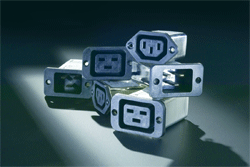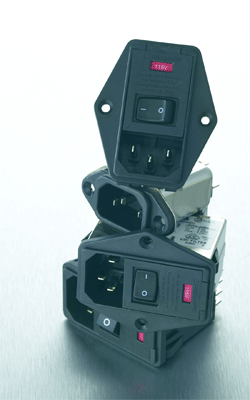Interpower Corporation (Oskaloosa, IA) is the premier supplier of power systems components for electrical and electronic equipment. Visit http://www.interpower.com.
EEs can save time and money by incorporating the right power-entry module
BY LUCY A. SNYDER
Engineers in charge of designing electronics and electrical appliances can save time (and money for their companies) by incorporating power-entry modules (PEMs). PEMs are composed of at least two power components: an inlet power connector—usually a standard ac IEC 60320 inlet—and a mounting housing.

Power-entry modules are available with many options to suit a variety of applications.
The modules also often incorporate other elements such as power conditioners and filters, on/off power switches, voltage selectors, fuses, circuit breakers, overload sensors and protectors, electromagnetic shielding, locking/security mechanisms, and water/oil-resistant seals. Four or five different power components may be incorporated into a single module. PEMs can be connected to their boards through a variety of different methods.
PEM advantages
Using PEMs may at first seem to present no cost advantage to a company, since the raw-material expense of a PEM is usually no better than the base cost of the components it contains. However, the modules can save money at all other levels of the engineering and manufacturing process by streamlining designs, simplifying inventory, and reducing the time and complexity of product assembly.
The reduction in the number of components that must be kept on hand may be particularly attractive to small and midsized companies with limited warehouse space. Companies of all sizes can get their products to market more quickly with fewer costs related to installation labor.
And, once the PEM-incorporating devices are on the market, companies are likely to see better customer satisfaction because PEMs provide nontrivial safety advantages over their alternatives. All modules should be built to the safety specifications and standards of oversight groups in the countries they will be used in, such as Underwriters Laboratories (UL), British Standards Institution (BSI) and the Canadian Standards Association (CSA).
However, it is important to verify that the modules you use have been thoroughly tested and certified. Most PEMs sequester high-voltage components away from case-cracking users, and the modules are designed so that users must completely remove power cords before they swap out fuses or perform other maintenance. The risk of electric shock is therefore significantly reduced.
Choosing PEMs
Once your company has decided to use PEMs in its designs, you will need to select the model that is best for your project based on the various features available in the different modules on the market. Your device’s power consumption is the first and foremost deciding factor.
Ac modules have been most common, but dc PEMs are gaining popularity, particularly in telecommunications devices. The modules generally handle currents up to 10 A (sometimes up to 20 A) and 250 V.
Corcom’s modules handle 1 to 10 A, Interpower’s modules handle 4 to 10 A, Spectrum Control’s handle 1 to 15 A, and Schurter offers modules that handle up to 20 A. Designers must also consider the maximum rated voltage of a PME, which indicates how much voltage the module can safely carry into your device.
The next consideration is the size of your device’s board and the type of connectors it must use. This is another area in which modules are advantageous, because they can save considerable panel space. Some of the smallest modules on the market are made by Interpower.
Mounting orientation
Mounting style and orientation are related considerations. Depending on the model, PEMs may be joined to boards with screws, tabs, quick connectors, by soldering, or can be simply snapped into place. Snap-in modules are easiest to install and therefore provide companies with the best savings in assembly labor.
Power management
The next set of PEM features must be chosen based on what kind of power management and conditioning your device needs. An on/off power switch is a fairly basic need for most devices. Modules featuring single-throw, double-pole switches; for best quality, seek a medical-grade switch (see below). Most manufacturers offer modules with a choice of vertical or horizontal orientation.
Your device may also need a voltage selector if it is going to be marketed in multiple countries. These selectors allow a device to be run on 115 or 230 Vac. In some modules, voltage changes are made by extracting and rotating the fuse holder.
PEMs and fuses
Fuses are an important safety feature in any power-entry module. Modules can come in either single- or double-fused versions.
For best flexibility and circuit protection, look for PEMs that allow you to easily convert a single-fused module to a double-fused one. Fuses are often sold separately from PEMs; care must be taken when choosing fuses to install in modules, because not every fuse of a certain amperage rating will function in a fuseholder of the same nominal rating. To prevent device failures and fires, designers should consult the specifications provided by the manufacturers.

Medical-grade power-entry modules must adhere to low-leakage-current regulations.
Shielding
Power filters with EMI shielding are also important in ensuring device performance and durability. Metal screening protects devices from EMI, which can be a particular problem in environments with high-frequency electromagnetic emissions.
Some modules may use RFI/EMI filters, which are special circuits designed to eliminated electrical noise. “Dirty” power can easily cause device malfunctions, and filter circuits can also prevent the device from creating electrical noise that could cause problems in other equipment nearby.
Circuit protection
Circuit protection and power conditioning is especially important in devices used in hospitals. Because people’s lives are at stake, hospital-grade PEMs are held to much higher performance standards than general-use modules.
Hospital modules are equipped with powerful line filters to control noise and strong shock-safe fuseholders with double fuses; they sometimes incorporate surge protectors and circuit breakers. Equipment that is attached directly to a hospital patient must adhere to low-leakage current regulations to eliminate the risk of electrical shock as much as possible. Hospital PEMs are also expected to resist accidental unplugging and to display far more durability than general-use modules.
■
Advertisement
Learn more about Interpower





